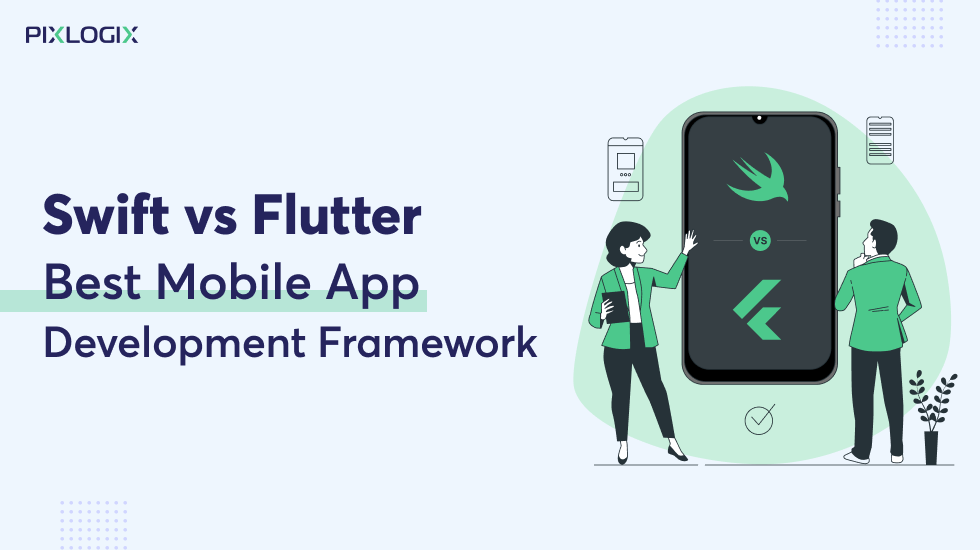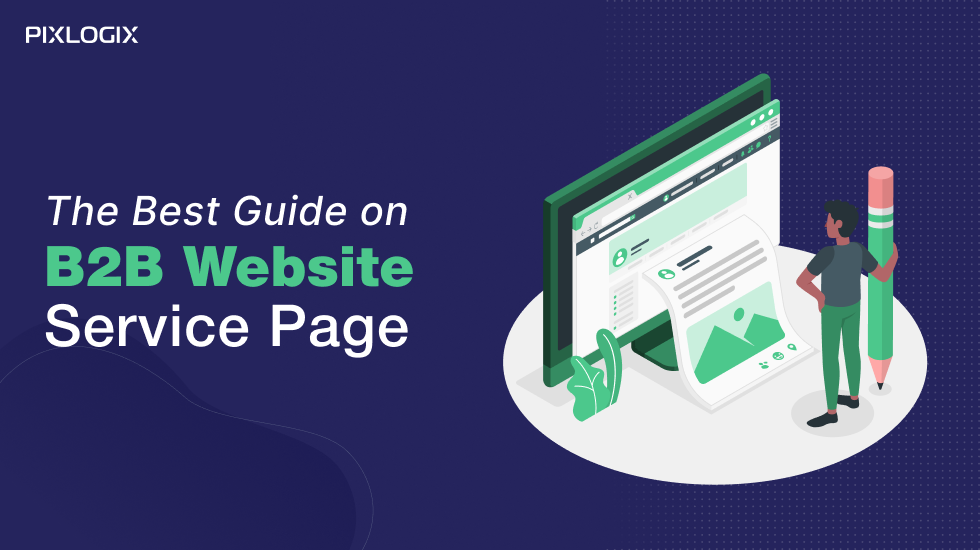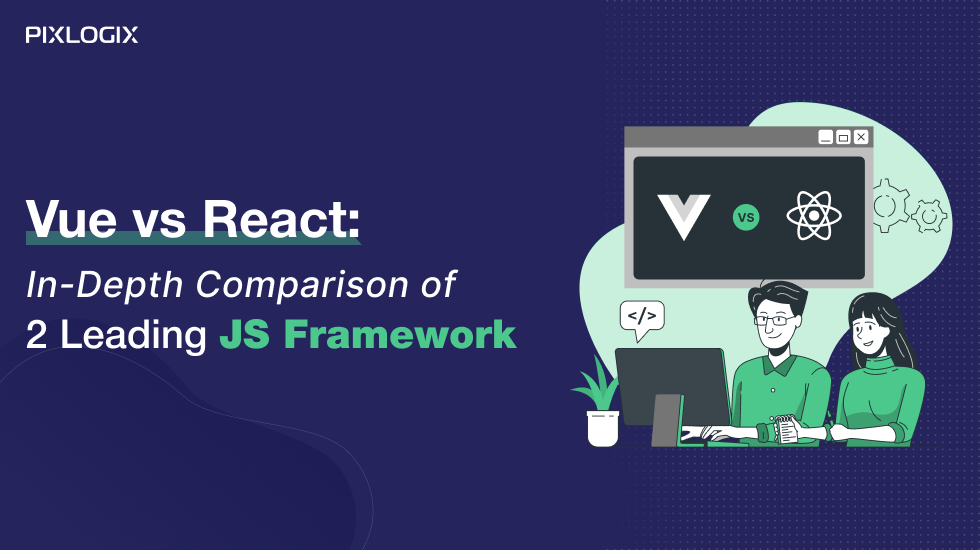Swift vs Flutter | Best Mobile App Development Framework

- Last Updated On March 18, 2024
- 11 min read
Flutter and Swift are top technologies for iOS app development. But, businesses are often confused between Swift vs Flutter for selecting the right Mobile app development platform.
For organizations that provide iOS app development services, Flutter and Swift are in-demand technologies. Flutter is a Google open-source framework for generating cross-platform applications, whereas Swift is an Apple programming language designed exclusively for iOS, macOS, watchOS, and tvOS app development.
To learn in depth read further.
An Overview of Swift vs Flutter
Flutter versus Swift for iOS has been one of the most hotly debated subjects. Let us have a look at both to acquire a better idea.
Flutter
Flutter is a cross-platform user interface toolkit designed specifically for code reuse across multiple operating platforms, such as Android and iOS. It is open-source, free, and written in the Dart object-oriented programming language. Flutter, a strong mobile framework, was created by combining all of the greatest Google concepts and technology.
Flutter is a very innovative iOS development platform. It has several new capabilities that have never been seen in other cross-platform before. The combination of the Skia graphics library and Material Design leads to the production of mobile apps for start-ups that enable lightning-fast transitions and are packed with design components that are known to blend smoothly into the native selves of Android and iOS.
Here are the top 10 features of Flutter iOS mobile App development:-
- Hot Reload
- Cross-platform Development
- Widgets System
- Fast Performance
- Expressive UI
- Material Design and Cupertino
- Rich Animation Support
- Access to Native Features
- Community and Packages
- Open-source
Swift
Apple developed Swift as a programming language. It is claimed to be an enhanced version of the Objective-C language in terms of syntax, readability, safety, and maintainability. Swift is based on standards shared by other programming languages. Swift has grown tremendously since its creation and introduction in 2014, as has the development community surrounding it.
Swift should be used when developing an iOS-specific app with functionality as the primary focus. Swift is a good choice for scalable apps with sophisticated architecture that demand a high standard when contrasted to other advantages of a cross-platform programming tool, such as faster time-to-market and simplicity of development.
The software takes less time and money to create because of its concise syntax. Swift also employs the quickest algorithm calculation metrics, which increases speed. As a result, it is a popular option among iOS app developers.
Here are the top features of Swift:-
- Fast and Efficient Technology
- Secured Platform
- Modern Syntax
- Options
- Type Inference
- Closures
- Automatic Reference Counting
- Protocol-Oriented Programming
- Swift Package Manager
- Open Source
Some Top Latest Facts and Stats About Swift vs Flutter
Here are some latest stats and facts about Flutter and Swift that will help you compare Swift vs Flutter for your business.
Flutter
- As of May 2023, Flutter has over 2 million active users.
- Flutter is used by over 100,000 organizations worldwide, including Google, Alibaba, and Tencent.
- Flutter apps are available on over 1.5 billion devices.
- Flutter is the fastest-growing cross-platform mobile app development framework.
- Flutter is a cross-platform framework, which means it can be used to develop apps for both iOS and Android.
- Flutter is known for its beautiful and performant user interfaces.
Swift
- As of May 2023, Swift has over 3 million active developers.
- Swift is used by over 80% of new iOS apps.
- Swift is the fastest-growing programming language in the world.
- Swift is used to develop various apps, including games, social media, and productivity apps.
- Swift is a compiled language, which means it is converted into machine code before it is executed. This makes Swift apps faster than apps written in interpreted languages, such as JavaScript.
- Swift is a modern and expressive language that is easy to learn and use.
Swift vs Flutter: Which One is Best for Your Business?
The distinction between Flutter and Swift is critical in the development process. Flutter app development differs from Swift app development when the development process is considered.
#1: Availability
The accessibility features of the program improve the UI-UX design for users with impairments. With iPhone app creation, you may also improve their life with little effort by making applications available to everyone.
Because Apple’s native tools already have accessibility embedded into the UI Kit framework, there is no compelling reason to import a separate framework to offer flexible support in native apps.
The Accessibility API is provided by Apple; however, developers must provide precise availability data to each UI component in the iOS application using the UI Accessibility function.
Flutter requires improvement in order to generate better accessibility-supporting applications for individuals with impairments. The Flutter handbook should include advice on how to make Flutter apps more accessible. In the Swift vs Flutter comparison, Swift outperforms Flutter in this area.
#2: The Onboarding Procedure
The onboarding process for native iOS development is less time-consuming and involves less configuration than Flutter-based iOS app development.
All you need to get started is a macOS system and XCode. Several online resources and books are available for studying Swift and iOS development. Flutter requires XCode and other Flutter technologies to get started designing iOS applications. Because Flutter is a newer technology, there are fewer development resources accessible than for native iOS app development.
#3: Efficiency
When it comes to Swift vs Flutter speed, you should be aware that, once again, the fact that Swift is the default language for iOS apps gives a significant benefit. You should expect improved execution for jobs that need a lot of computing power. In terms of performance, Swift may be the superior choice. At this stage, you must consider all of the mobile app performance metrics.
Flutter, on the other hand, does not lag. First and foremost, Dart employs a waste specialist. Second, AOT (early) is set up to allow for rapid communication with the device. Except when you need to use the iOS platform, Flutter will behave substantially identically to native Swift.
#4: Development Price
Because both technologies are open-source, there is no additional expense to utilize these two platforms. Hiring knowledgeable and talented developers for mobile app development is made easier by the abundance of software development firms available.
If you create an iOS app, the final cost will be rather low. However, you may target more customers by designing two Flutter applications for comparable price offerings. You may create an app for both iOS and Android using a single code base.
#5: Development Period
You may learn how long it takes to construct each app by using a command in Flutter apk. Flutter iOS app development is often slower than Swift in terms of clean builds. Flutter certainly becomes faster after the initial clean builds.
The Swift native iOS app development time may be calculated using the XCode command line. The build time is displayed when you have finished building your app and executed the build command from the product menu. Swift took roughly 13.334 seconds to complete a clean build.
Swift beats Flutter iOS build in this race because it runs consistently quicker during the clean build and subsequent phases.
#6: Learning Curve
The word “learning curve” refers to the ease or difficulty of learning a new app development technique. It is one of the most crucial factors to consider when choosing one iOS app development tool over another. Flutter often exceeds the bulk of other commonly used mobile app frameworks in terms of learning curve.
Flutter provides app developers with a rich set of tutorials and well-organized, incredibly user-friendly documentation. On the other hand, Swift has been accessible since 2014 and provides comprehensive instruction for designing native iOS apps.
Overall, learning Swift or Flutter is dependent on the developer’s preference.
#7: Application Dimensions
After comparing every feature of native and Flutter apps, it’s time to compare the sizes of native XCode and Flutter apps. The XCode-derived data may be used to generate the app artifact for native iOS. The native app is around 25 MB in size.
The build artifacts for Flutter apps are created in the Flutter project’s build/iOS/Debug-iPhone simulator directory. The locally built software has a file size of 52.4 MB. The Flutter app is significantly larger than the native app, but it has app icons and other components incorporated into it.
This comparison shows that the Flutter apps appear to be larger in size. You should also know if you want to learn Swift or Flutter at this point.
Conclusion
You may choose which mobile app development framework to employ based on the variables listed above. Several frameworks are available, and understanding their properties aids in selecting the best one.
If you want the finest option for your mobile app development, you should spend some time researching what is available on the market and how they compare. Swift vs Flutter is a never-ending discussion about which is the finest mobile app development framework, and it only becomes more heated as time passes.
Flutter’s documentation and popularity are rising on a regular basis, but it is still not as good as Swift’s for iOS app development. Flutter apps are simple to maintain and inexpensive, while native apps are created for their unique platforms, taking full advantage of iOS and software capabilities.
These apps load faster in the app, resulting in a considerably improved user experience and performance. They can have direct access to the device’s hardware, such as the microphone, camera, GPS, and so on. Finally, the choice between Flutter and Swift is determined by the needs of your project. If you have any more questions or would like to discuss this further, don’t hesitate to contact the experienced iOS Mobile App Development Agency, Pixlogix Infotech Pvt. Ltd.
Samir Bhimbha
Samir Bhimbha is the Founder & CEO of Pixlogix Infotech Pvt. Ltd. which offers web and app solutions to fulfill business's online needs and help to improve their online presence with many clients in the USA, Europe, Australia, and more. He is a skilled entrepreneur, web designer, developer, and team leader who can handle every situation. With 15+ years of experience in UX/UI design and web development, he is leading a team of IT professional talents.
Related Post
Get in Touch Now!
Have a word with our expert consultants about your next project to get suggestive guidance & proposal.
Sales Inquiry
Chat with us about your project for a custom solution and quote.




